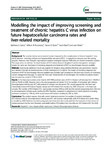Modelling the impact of improving screening and treatment of chronic hepatitis C virus infection on future hepatocellular carcinoma rates and liver-related mortality
| dc.contributor.author | Cramp, Matthew | |
| dc.contributor.author | Rosenberg, WM | |
| dc.contributor.author | Ryder, SD | |
| dc.contributor.author | Blach, S | |
| dc.contributor.author | Parkes, J | |
| dc.date.accessioned | 2016-12-15T15:18:55Z | |
| dc.date.available | 2016-12-15T15:18:55Z | |
| dc.date.issued | 2014-12 | |
| dc.identifier.issn | 1471-230X | |
| dc.identifier.issn | 1471-230X | |
| dc.identifier.other | 137 | |
| dc.identifier.uri | http://hdl.handle.net/10026.1/8127 | |
| dc.description.abstract |
BACKGROUND: The societal, clinical and economic burden imposed by the complications of chronic hepatitis C virus (HCV) infection - including cirrhosis and hepatocellular carcinoma (HCC) - is expected to increase over the coming decades. However, new therapies may improve sustained virological response (SVR) rates and shorten treatment duration. This study aimed to estimate the future burden of HCV-related disease in England if current management strategies remain the same and the impact of increasing diagnosis and treatment of HCV as new therapies become available. METHODS: A previously published model was adapted for England using published literature and government reports, and validated through an iterative process of three meetings of HCV experts. The impact of increasing diagnosis and treatment of HCV as new therapies become available was modelled and compared to the base-case scenario of continuing current management strategies. To assess the 'best case' clinical benefit of new therapies, the number of patients treated was increased by a total of 115% by 2018. RESULTS: In the base-case scenario, total viraemic (HCV RNA-positive) cases of HCV in England will decrease from 144,000 in 2013 to 76,300 in 2030. However, due to the slow progression of chronic HCV, the number of individuals with cirrhosis, decompensated cirrhosis and HCC will continue to increase over this period. The model suggests that the 'best case' substantially reduces HCV-related hepatic disease and HCV-related liver mortality by 2020 compared to the base-case scenario. The number of HCV-related HCC cases would decrease 50% by 2020 and the number progressing from infection to decompensated cirrhosis would decline by 65%. Therefore, compared to projections of current practices, increasing treatment numbers by 115% by 2018 would reduce HCV-related mortality by 50% by 2020. CONCLUSIONS: This analysis suggests that with current treatment practices the number of patients developing HCV-related cirrhosis, decompensated cirrhosis and HCC will increase substantially, with HCV-related liver deaths likely to double by 2030. However, increasing diagnosis and treatment rates could optimise the reduction in the burden of disease produced by the new therapies, potentially halving HCV-related liver mortality and HCV-related HCC by 2020. | |
| dc.format.extent | 137- | |
| dc.format.medium | Electronic | |
| dc.language | en | |
| dc.language.iso | eng | |
| dc.publisher | Springer Science and Business Media LLC | |
| dc.subject | Hepatitis C virus | |
| dc.subject | Hepatocellular carcinoma | |
| dc.subject | Cirrhosis | |
| dc.subject | Decompensated cirrhosis | |
| dc.title | Modelling the impact of improving screening and treatment of chronic hepatitis C virus infection on future hepatocellular carcinoma rates and liver-related mortality | |
| dc.type | journal-article | |
| dc.type | Journal Article | |
| dc.type | Research Support, Non-U.S. Gov't | |
| plymouth.author-url | https://www.webofscience.com/api/gateway?GWVersion=2&SrcApp=PARTNER_APP&SrcAuth=LinksAMR&KeyUT=WOS:000340632700001&DestLinkType=FullRecord&DestApp=ALL_WOS&UsrCustomerID=11bb513d99f797142bcfeffcc58ea008 | |
| plymouth.issue | 1 | |
| plymouth.volume | 14 | |
| plymouth.publication-status | Published | |
| plymouth.journal | BMC Gastroenterology | |
| dc.identifier.doi | 10.1186/1471-230x-14-137 | |
| plymouth.organisational-group | /Plymouth | |
| plymouth.organisational-group | /Plymouth/Faculty of Health | |
| plymouth.organisational-group | /Plymouth/Faculty of Health/Peninsula Medical School | |
| plymouth.organisational-group | /Plymouth/REF 2021 Researchers by UoA | |
| plymouth.organisational-group | /Plymouth/REF 2021 Researchers by UoA/UoA01 Clinical Medicine | |
| plymouth.organisational-group | /Plymouth/Research Groups | |
| plymouth.organisational-group | /Plymouth/Research Groups/Institute of Translational and Stratified Medicine (ITSMED) | |
| plymouth.organisational-group | /Plymouth/Research Groups/Institute of Translational and Stratified Medicine (ITSMED)/CBR | |
| plymouth.organisational-group | /Plymouth/Users by role | |
| plymouth.organisational-group | /Plymouth/Users by role/Academics | |
| dc.publisher.place | England | |
| dcterms.dateAccepted | 2014-07-17 | |
| dc.identifier.eissn | 1471-230X | |
| dc.rights.embargoperiod | No embargo | |
| rioxxterms.versionofrecord | 10.1186/1471-230x-14-137 | |
| rioxxterms.licenseref.uri | http://www.rioxx.net/licenses/all-rights-reserved | |
| rioxxterms.licenseref.startdate | 2014-08-07 | |
| rioxxterms.type | Journal Article/Review |


